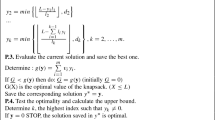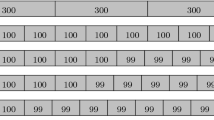Abstract
In this paper we propose an algorithm for the constrained two-dimensional cutting stock problem (TDC) in which a single stock sheet has to be cut into a set of small pieces, while maximizing the value of the pieces cut. The TDC problem is NP-hard in the strong sense and finds many practical applications in the cutting and packing area. The proposed algorithm is a hybrid approach in which a depth-first search using hill-climbing strategies and dynamic programming techniques are combined. The algorithm starts with an initial (feasible) lower bound computed by solving a series of single bounded knapsack problems. In order to enhance the first-level lower bound, we introduce an incremental procedure which is used within a top-down branch-and-bound procedure. We also propose some hill-climbing strategies in order to produce a good trade-off between the computational time and the solution quality. Extensive computational testing on problem instances from the literature shows the effectiveness of the proposed approach. The obtained results are compared to the results published by Alvarez-Valdés et al. (2002).
Similar content being viewed by others
References
R. Alvarez-Valdés, A. Parajon, and J.M. Tamarit, “A tabu search algorithm for large-scale guillotine (un)constrained' two-dimensional cutting problems,” Computers and Operations Research, vol. 29,no 7, pp. 925–947, 2002.
M. Arenales and R. Morabito, “An overview of and-or-graph approaches to cutting and packing problems,” Decision Making under Conditions of Uncertainly, ISBN 5-86911-161-7, pp. 207–224, 1997.
J.E. Beasley, “Algorithms for unconstrained two-dimensional guillotine cutting,” Journal of the Operational Research Society, vol. 36, pp. 297–306, 1985.
N. Christofides and E. Hadjiconstantinou, “An exact algorithm for orthogonal 2-D cutting problems using guillotine cuts,” European Journal of Operational Research, vol. 83, pp. 21–38, 1995.
N. Christofides and C. Whitlock, “An algorithm for two-dimensional cutting problems,” Operations Research, vol. 2, pp. 31–44, 1977.
V.-D. Cung and M. Hifi, “Handling lower bound constraints in two-dimensional cutting problems,” International Symposium on Mathematical Programming, Atlanta, August 2000.
V-D. Cung, M. Hifi, and B. Le Cun, “Constrained two-dimensional cutting stock problems: A best-first branch-and-bound algorithm,” International Transactions in Operational Research, vol. 7, pp. 185–210, 2000a.
V-D. Cung, M. Hifi, and B. Le Cun, “Constrained two-dimensional cutting stock problems: The NMVB approach and the duplicate test revisited,” Cahiers de la MSE, 2000-127, Série Bleue, Université Paris 1.
H. Dyckhoff, “A typology of cutting and packing problems,” European Journal of Operational Research, vol. 44, pp. 145–159, 1990.
D. Fayard, M. Hifi, and V. Zissimopoulos, “An efficient approach for large-scale two-dimensional guillotine cutting stock problems,” Journal of the Operational Research Society, vol. 49, pp. 1270–1277, 1998.
P.C. Gilmore and R.E. Gomory, “Multistage cutting problems of two and more dimensions,” Operations Research, vol. 13, pp. 94–119, 1965.
P.C. Gilmore and R.E. Gomory, “The theory and computation of knapsack functions,” Operations Research, vol. 14, pp. 1045–1074, 1966.
J.C. Herz, “A recursive computing procedure for two-dimensional stock cutting,” IBM Journal of Research and Development, vol. 16, pp. 462–469, 1972.
M. Hifi, “The DH/KD algorithm: A hybrid approach for unconstrained cutting problems,” European Journal of Operational Research, vol. 97, pp. 41–52, 1997a.
M. Hifi, “An improvement of Viswanathan and Bagchi's exact algorithm for cutting stock problems,” Computers and Operations Research, vol. 24, pp.727–736, 1997b.
M. Hifi, Contribution à la résolution de quelques problèmes difficiles de l'optimisation combinatoire, Habilitation Thesis. PRiSM, Université de Versailles St-Quentin en Yvelines, 1999.
M. Hifi and C. Roucairol, “Approximate and exact algorithms for constrained (un)weighted two-dimensional two-staged cutting stock problems,” Journal of Combinatorial Optimization, vol. 5, pp. 464–494, 2001.
M. Hifi and V. Zissimopoulos, “A recursive exact algorithm for weighted two-dimensional cutting problems,” European Journal of Operational Research, vol. 91, pp. 553–564, 1996.
M. Hifi and V. Zissimopoulos, “Constrained two-dimensional cutting: An improvement of Christofides and Whitlock's exact algorithm,” Journal of the Operational Research Society, vol. 5, pp. 8–18, 1997.
L.V. Kantorovich, “Mathematical methods of organizing and planning production,” Management Science, vol. 6, pp. 363–422, 1960.
A. Lodi and M. Monaci, “Integer linear programming models for two-staged cutting stock problems,” Technical Report, DEIS, University of Bologna, Italy, 2000.
S. Martello and P. Toth, Knapsack Problems, Algorithms and Computer Implementations, John Wiley & Sons Ltd: Chichester, 1990.
R. Morabito, M. Arenales, and V. Arcaro, “An and-or-graph approach for two-dimensional cutting problems,” European Journal of Operational Research, vol. 58,no 2, pp. 263–271, 1992.
R. Morabito and M. Arenales, “Staged and constrained two-dimensional guillotine cutting problems: An and/or-graph approach,” European Journal of Operational Research, vol. 94,no 3, pp. 548–560, 1996.
J.F. Oliveira and J.S. Ferreira, “An improved version of Wang's algorithm for two-dimensional cutting problems,” European Journal of Operational Research, vol. 44, pp. 256–266, 1990.
J.F. Oliveira and J.S. Ferreira, “A faster variant of the Gilmore and Gomory technique for cutting stock problems,” JORBEL, vol. 34,no 1, pp. 23–38, 1994.
P.E. Sweeney and E. Paternoster, “Cutting and packing problems: A categorized application-oriented research bibliography,” Journal of the Operational Research and Society, vol. 43, pp. 691–706, 1992.
S. Tschöke and N. Holthöfer, “A new parallel approach to the constrained two-dimensional cutting stock problem,” in Proceedings of the Second International Workshop. Parallel Algorithms for Irregular Structured Problems, LNCS 980, pp. 285–300, 1995.
F.J. Vasko, “A computational improvement to Wang's two-dimensional cutting stock algorithm,” Computers and Industrial Engineering, vol. 16, pp. 109–115, 1989.
K.V. Viswanathan and A. Bagchi, “Best-first search methods for constrained two-dimensional cutting stock problems,” Operations Research, vol. 41,no. 4, pp. 768–776, 1993.
P.Y. Wang, “Two algorithms for constrained two-dimensional cutting stock problems,” Operations Research, vol. 31,no. 3, pp. 573–586, 1983.
Author information
Authors and Affiliations
Rights and permissions
About this article
Cite this article
Hifi, M. Dynamic Programming and Hill-Climbing Techniques for Constrained Two-Dimensional Cutting Stock Problems. Journal of Combinatorial Optimization 8, 65–84 (2004). https://doi.org/10.1023/B:JOCO.0000021938.49750.91
Issue Date:
DOI: https://doi.org/10.1023/B:JOCO.0000021938.49750.91




